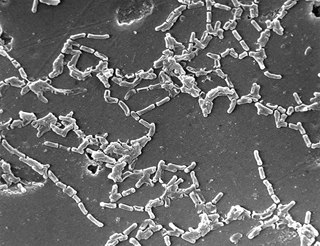Related Research Articles

Rhizobium is a genus of Gram-negative soil bacteria that fix nitrogen. Rhizobium species form an endosymbiotic nitrogen-fixing association with roots of (primarily) legumes and other flowering plants.

Sinorhizobium meliloti are an aerobic, Gram-negative, and diazotrophic species of bacteria. S. meliloti are motile and possess a cluster of peritrichous flagella. S. meliloti fix atmospheric nitrogen into ammonia for their legume symbionts, such as alfalfa. S. meliloti forms a symbiotic relationship with legumes from the genera Medicago, Melilotus and Trigonella, including the model legume Medicago truncatula. This symbiosis promotes the development of a plant organ, termed a root nodule. Because soil often contains a limited amount of nitrogen for plant use, the symbiotic relationship between S. meliloti and their legume hosts has agricultural applications. These techniques reduce the need for inorganic nitrogenous fertilizers.

Mycobacterium chelonae is a species of the phylum Actinobacteria, belonging to the genus Mycobacterium. Mycobacterium chelonae is a rapidly growing mycobacterium, that is found all throughout the environment including sewage and tap water. It can occasionally cause opportunistic infections of humans.

Sinorhizobium/Ensifer is a genus of nitrogen-fixing bacteria (rhizobia), three of which have been sequenced.

Bradyrhizobium japonicum is a species of legume-root nodulating, microsymbiotic nitrogen-fixing bacteria. The species is one of many Gram-negative, rod-shaped bacteria commonly referred to as rhizobia. Within that broad classification, which has three groups, taxonomy studies using DNA sequencing indicate that B. japonicum belongs within homology group II.

Mesorhizobium is a genus of Gram-negative soil bacteria. At least one, the nitrogen fixing species, Mesorhizobium loti, forms symbiotic root nodules with plants in the genus Lotus. Strain MAFF303099 of M. japonicum has been fully sequenced.
Bacterial taxonomy is the taxonomy, i.e. the rank-based classification, of bacteria.
Neorhizobium galegae is a Gram negative root nodule bacteria. It forms nitrogen-fixing root nodules on legumes in the genus Galega.
Sinorhizobium fredii is a nitrogen fixing bacteria of the genus Sinorhizobium. It is a fast-growing root nodule bacteria. Sinorhizobium fredii exhibit a broad host-range and are able to nodulate both determinant hosts such as soy as well as indeterminate hosts including the pigeon pea. Because of their ease of host infection there is interest in their genetics and the symbiotic role in host infection and nodule formation.
Rhizobium gallicum is a Gram-negative root-nodule bacterium. It forms nitrogen-fixing root nodules on legumes, being first isolated from those of Phaseolus vulgaris.
Mesorhizobium tianshanense, formerly known as Rhizobium tianshanense, is a Gram negative species of bacteria found in the root nodules of many plant species. Its type strain is A-1BS.
Mesorhizobium plurifarium is a species of root nodule bacteria first isolated from Acacia species in Senegal. Its type strain is ORS 1032.
Rhizobium hainanense is a Gram negative root nodule bacteria. Strain CCBAU 57015 (166) is the type strain.
Mesorhizobium amorphae is a species of root nodule bacteria first isolated from Amorpha fruticosa species in China. It is purported to be native to American soil. Its genome has been sequenced. Its type strain is ACCC 19665.
Rhizobium mongolense is a Gram negative root nodule bacteria, which nodulates and forms nitrogen-fixing symbioses with Medicago ruthenica. Its type strain is USDA 1844.
Mesorhizobium chacoense is a gram-negative, aerobic, non-spore-forming, motile bacteria from the genus of Mesorhizobium which was isolated from root nodules of Prosopis alba in the Chaco Arido region in Argentina.
Mesorhizobium ciceri is a gram-negative, nitrogen-fixing motile bacteria from the genus of Mesorhizobium which was isolated from Chickpea nodules of Cicer arietinum in Spain. Rhizobium cicero was transferred to Mesorhizobium ciceri.
Mesorhizobium huakuii is a bacterium from the genus Mesorhizobium which was isolated from the legume Astragalus sinicus in Nanjing in China. Rhizobium huakuii was transferred to Mesorhizobium huakuii.
Mesorhizobium mediterraneum is a bacterium from the genus Mesorhizobium, which was isolated from root nodule of the Chickpea in Spain. The species Rhizobium mediterraneum was subsequently transferred to Mesorhizobium mediterraneum. This species, along with many other closely related taxa, have been found to promote production of chickpea and other crops worldwide by forming symbiotic relationships.
Sinorhizobium medicae is a species of gram-negative, nitrogen-fixing, rod-shaped bacteria. They can be free-living or symbionts of leguminous plants in root nodules. S.medicae was first isolated from root nodules on plants in the genus Medicago. Some strains of S.medicae, like WSM419, are aerobic. They are chemoorganotrophic mesophiles that prefer temperatures around 28 °C. In addition to their primary genome, these organisms also have three known plasmids, sized 1,570,951 bp, 1,245,408 bp and 219,313 bp.
References
- ↑ Jarvis, B. D. W.; Van Berkum, P.; Chen, W. X.; Nour, S. M.; Fernandez, M. P.; Cleyet-Marel, J. C.; Gillis, M. (1 July 1997). "Transfer of Rhizobium loti, Rhizobium huakuii, Rhizobium ciceri, Rhizobium mediterraneum, and Rhizobium tianshanense to Mesorhizobium gen. nov". International Journal of Systematic Bacteriology. 47 (3): 895–898. doi: 10.1099/00207713-47-3-895 .
- ↑ Jarvis, B. D. W.; Pankhurst, C. E.; Patel, J. J. (1982). "Rhizobium loti, a New Species of Legume Root Nodule Bacteria". International Journal of Systematic Bacteriology. 32 (3): 378–380. doi: 10.1099/00207713-32-3-378 . ISSN 0020-7713.
- ↑ Kaneko, T. (1 January 2000). "Complete Genome Structure of the Nitrogen-fixing Symbiotic Bacterium Mesorhizobium loti". DNA Research. 7 (6): 331–338. doi: 10.1093/dnares/7.6.331 . PMID 11214968.
- ↑ Pitcher, Robert S.; Brissett, Nigel C.; Doherty, Aidan J. (2007). "Nonhomologous End-Joining in Bacteria: A Microbial Perspective". Annual Review of Microbiology . Annual Reviews. 61 (1): 259–282. doi:10.1146/annurev.micro.61.080706.093354. ISSN 0066-4227.